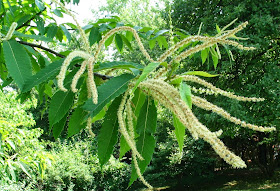 |
| American Chestnut Pollen Stalks: Photo by Timothy Van Vliet |
The American chestnut, Castanea
dentata, became virtually extinct as a species, almost entirely gone from
the Eastern United States by the 1950s. Before
that time it had represented 25% to 30% of the forest canopy from Maine to Georgia.
An infestation arrived from Asia, probably
introduced with Asian chestnut trees brought by horticulturists. A fungus, first
noticed in 1904, but probably already present in several areas of this country,
had become a killer of native chestnut trees.
The Asian chestnut species has coexisted with the fungus for
millions of years and has developed ways to withstand its attacks; but the
American chestnut is helpless. To make things worse, the fungus spores travel
easily through air and show great resistance to weather changes. So, what came
to be known as the American chestnut blight spread through the entire range of
this species killing nearly all the trees in less than half a century.
Many species that depended on the nuts for food, from
chipmunks to bears, experienced significant losses. In fact, populations of
squirrels and wild turkeys crashed. Squirrels bounced back on their own, but turkeys needed human assistance. The effect traveled up the food
chain. Goshawks and other predators felt the impact. Gone with the chestnut
trees, although less noticed by most, were some insects that fed on this tree;
probably seven species of moths became extinct.
Humans also suffered the loss grievously. Not only the nuts
but the timber were valued and now they were gone. Dedicated scientists and
agronomists of the Department of Agriculture fought for years to slow down or stop the
march of the parasitic fungus, resorting to a variety of methods to heal the
trees or to introduce pests that weakened the fungus. All were futile.
What happened to the pollinators of this species? Pollination
research was almost non-existent when the trees were abundant and now that they
are almost gone nobody is gathering such information. That is why I was glad to
read the observations of one old enough to remember what things were like when
the tree was still alive. His comments show that non-native honey bees visited
the flowers in huge numbers. But, what about the native pollinators, the ones
that had lived for thousands of years with the tree and its flowers?
For lack of American chestnut trees, we can use proxies, the
closest relatives of the deceased, to gather some indirect information on their pollination . The flowers of species of chestnuts are
strongly scented and attract numerous insect visitors, not just honey bees, but
also many species of solitary bees, butterflies, flower flies, and beetles. Specialist
honey producers sell a monofloral honey made from blossoms of the European
chestnut, Castanea sativa. It is
strong tasting and darker than other honeys. Chinese chestnut trees, Castanea mollissima, grow in some
gardens and parks where I regularly go for walks. The scent of their flowers is
almost overpowering in the months of May and June.
We can assume that American chestnuts were also visited by
many insects and that they were pollinated by them. They too must have suffered
from the near disappearance of the species. Some of them may have been able to
adapt and resort to pollen and nectar from other plants although no other trees
bloom as heavily as chestnuts in late spring and early summer. The American
chestnut disappearance must have been a severe blow to all of them. Perhaps
some of them, too, went nearly or totally extinct. Probably we'll never know.
The struggle to bring the chestnut back from its near
extinction continues. Horticulturists are resorting to a variety of approaches,
from controlling the virulence of the fungus to breeding new varieties of the
tree in an attempt to restore the American chestnut to its native geographic
range. Some strategies look more promising than others. All require enormous
effort. Let us hope that they succeed.
Freinkel, Susan. American
Chestnut: The Life, Death, and Rebirth of a Perfect Tree.
The American Chestnut Foundation
List of Articles
© Beatriz Moisset. 2013
The American Chestnut Foundation
List of Articles
© Beatriz Moisset. 2013